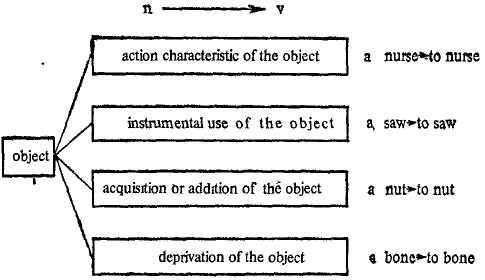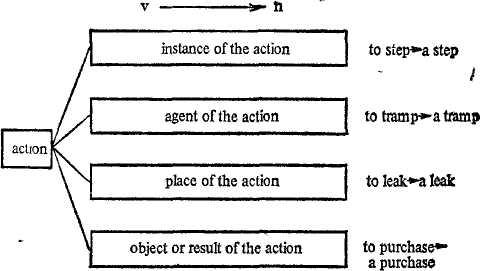As
one of the two words within a conversion pair is semantically derived
from the other, it is of great theoretical and practical importance
to determine the semantic relations between words related through
conversion. Summing up the findings of the linguists who have done
research in this field we can enumerate the following typical
semantic relations.
I. Verbs converted from nouns (denominal verbs).
This
is the largest group of words related through conversion. The
semantic relations between the nouns and verbs vary greatly. If the
noun refers to some object of reality (both animate and inanimate)
the converted verb may denote:
-
action
characteristic of the object, e.g. ape
n
— ape
v
— ‘imitate
in a foolish way’; butcher
n
— butcher
v
— ‘kill
animals for food, cut up a killed animal’; -
instrumental
use of the object, e.g. screw
n
— screw
v
— ‘fasten
with a screw’; whip
n
— whip
v
— ’strike
with a whip’; -
acquisition
or addition of the object, e.g. fish
n
— fish
v
— ‘catch
or try to catch fish’; coat
n
— ‘covering
of paint’
— coat
v
— ‘put
a coat of paint on’; -
deprivation
of the object, e.g. dust
n
— dust
v
— ‘remove
dust from something’; skin
n
— skin
v
— ’strip
off the skin from’; etc.
5* 131
II. Nouns converted from verbs (deverbal substantives).
The
verb generally referring to an action, the converted noun may denote:
-
instance
of the action, e.g. jump
v
— jump
n
— ’sudden
spring from the ground’; move
v
— move
n
— ‘a
change of position’; -
agent
of the action, e.g. help
v
— help n
— ‘a person
who helps’; it is of interest to mention that the deverbal
personal nouns denoting the doer are mostly derogatory, e.g. bore
v
— bore
n
— ‘a person that bores’; cheat
v
— cheat
n
— ‘a
person who cheats’; -
place
of the action, e.g. drive
v
— drive
n
— ‘a path
or road along which one drives’; walk
v
— walk
n
— ‘a
place for walking’; -
object
or result of the action, e.g. peel
v
— peel
n
— ‘the
outer skin of fruit or potatoes taken off; find
v
— find
и
— ’something
found,” esp. something valuable or pleasant’; etc.
For
convenience the typical semantic relations as briefly described above
may be graphically represented in the form of a diagram (see below,
pp. 132-133).
In
conclusion it is necessary to point out that in the case of
polysemantic words one and the same member of a conversion pair, a
verb or a noun, belongs to several of the above-mentioned groups
making different derivational bases. For instance, the verb dust
belongs
to Group 4
of
Denominal verbs (deprivation of the object) when it means ‘remove
dust from something’, and to Group 3
(acquisition
or addition of the object) when it means ‘cover with powder’; the
noun slide
is
referred to Group 3
of
Deverbal substantives (place of the action) when denoting ‘a
stretch of smooth ice or hard snow on which people slide’ and to
Group 2
(agent
of the action) when it refers to a part of an instrument or machine
that slides, etc.
Denominal Verbs
132
Deverbal Substantives
Every teacher wonders how to teach a word to students, so that it stays with them and they can actually use it in the context in an appropriate form. Have your students ever struggled with knowing what part of the speech the word is (knowing nothing about terminologies and word relations) and thus using it in the wrong way? What if we start to teach learners of foriegn languages the basic relations between words instead of torturing them to memorize just the usage of the word in specific contexts?
Let’s firstly try to recall what semantic relations between words are. Semantic relations are the associations that exist between the meanings of words (semantic relationships at word level), between the meanings of phrases, or between the meanings of sentences (semantic relationships at phrase or sentence level). Let’s look at each of them separately.
Word Level
At word level we differentiate between semantic relations:
- Synonyms — words that have the same (or nearly the same) meaning and belong to the same part of speech, but are spelled differently. E.g. big-large, small-tiny, to begin — to start, etc. Of course, here we need to mention that no 2 words can have the exact same meaning. There are differences in shades of meaning, exaggerated, diminutive nature, etc.
- Antonyms — semantic relationship that exists between two (or more) words that have opposite meanings. These words belong to the same grammatical category (both are nouns, adjectives, verbs, etc.). They share almost all their semantic features except one. (Fromkin & Rodman, 1998) E.g.
- Homonyms — the relationship that exists between two (or more) words which belong to the same grammatical category, have the same spelling, may or may not have the same pronunciation, but have different meanings and origins. E.g. to lie (= to rest) and to lie (= not to tell the truth); When used in a context, they can be misunderstood especially if the person knows only one meaning of the word.
Other semantic relations include hyponymy, polysemy and metonymy which you might want to look into when teaching/learning English as a foreign language.
At Phrase and Sentence Level
Here we are talking about paraphrases, collocations, ambiguity, etc.
- Paraphrase — the expression of the meaning of a word, phrase or sentence using other words, phrases or sentences which have (almost) the same meaning. Here we need to differentiate between lexical and structural paraphrase. E.g.
Lexical — I am tired = I am exhausted.
Structural — He gave the book to me = He gave me the book.
- Ambiguity — functionality of having two or more distinct meanings or interpretations. You can read more about its types here.
- Collocations — combinations of two or more words that often occur together in speech and writing. Among the possible combinations are verbs + nouns, adjectives + nouns, adverbs + adjectives, etc. Idiomatic phrases can also sometimes be considered as collocations. E.g. ‘bear with me’, ‘round and about’, ‘salt and pepper’, etc.
So, what does it mean to know a word?
Knowing a word means knowing all of its semantic relations and usages.
Why is it useful?
It helps to understand the flow of the language, its possibilities, occurrences, etc.better.
Should it be taught to EFL learners?
Maybe not in that many details and terminology, but definitely yes if you want your learners to study the language in depth, not just superficially.
How should it be taught?
Not as a separate phenomenon, but together with introducing a new word/phrase, so that students have a chance to create associations and base their understanding on real examples. You can give semantic relations and usages, ask students to look up in the dictionary, brainstorm ideas in pairs and so on.
Let us know what you do to help your students learn the semantic relations between the words and whether it helps.
Semantic relationships
Words are not expressed in isolation, in other words, they establish a relationship with each other to enrich the language. In order to establish this relationship, it is necessary to meet different criteria. In this case, we are going to see what are the meaning relationships that are established between the different words. We can find the following relationships: Semantic relations with examples in English
- Antonymy
- Semantic field
- Homonymy
- Polysemy
- Synonymy
1-Antonymy
The semantic relationship of antonymy between the different words occurs when two or more of them present an opposite meaning. Here are some examples of this:
- Cold hot.
- Open close.
- Break: fix.
- Do: undo.
- Clean: dirty.
- Laugh cry.
- Remember: forget.
- Black White.
- High Low.
- Old: young.
- Near far.
- Up and down.
- Early afternoon.
- Reject: accept.
- Live, die.
- Active passive.
- Funny: boring.
- Sunny cloudy.
- Sleeping Awake.
- Sewing: unstitching.
- Lose weight: gain weight.
- Join: separate.
- Suitable: inappropriate.
- Perfect: imperfect.
- Plausible: implausible.
- Conscious: Unconscious.
2-Semantic field
We continue listing the different semantic relationships talking about the semantic field. This relationship occurs when two or more words that are different from each other are related through meaning. That is, they all belong to the same semantic field. These words must always be included in the same grammatical category. To better understand this explanation, it will be necessary to provide a series of examples, we are going to see them:
- Semantic field of means of transport : car, truck, motorcycle, bicycle, bus, plane, ship, train, scooter … etc.
- Semantic field of the months of the year : January, February, March, April, May, June, July, August, September, October, November, December.
- Semantic field of the seasons : spring, summer, autumn, winter.
- Semantic field of clothing : pants, coat, socks, shirt, skirt, dress, shoes, tie, jacket, blouse … etc.
- Semantic field of furniture : table, chair, sofa, wardrobe, bed, armchair, worktop, door … etc.
- Semantic field of computing : mouse, keyboard, computer, software, hardware, program, camera, microphone, speaker, screen … etc.
- Kitchen semantic field : casserole, spoon, refrigerator, dishwasher, spoon, fork, knife, napkin, glass, coasters, crockery, saucepan, frying pan, pot … etc.
- Semantic field of education : student, teacher, blackboard, book, pencil, backpack, case, eraser, notebook, folder, pencil sharpener, pen, marker, paint … etc.
3-Homonymy
This semantic relationship occurs when two words that have different meanings are pronounced in the same way. They occur when the words come from two different grammatical families . Let’s see some examples of homonymy placed in a sentence: Semantic relations with examples in English
- My mother came from work early.
- The couple at the back table have ordered wine for dinner.
- Cut along the dotted line.
- He came out of the coma after 2 months.
- You must know how to put the comma in this sentence.
- The company had a very high capital .
- They went on a trip to the capital to celebrate his birthday.
- They had a very romantic date .
- In his book he quotes his work on several occasions.
4-Polysemy
The polysemy is also one of the semantic relationships of language. And it occurs when the same word has different meanings being written in the same way. Let’s look at some examples:
- Saw (tool for cutting; mountain range).
- Bank (place where money is kept; set of fish; place to sit).
- Bridge (place to cross a river; dental structure; accumulation of vacation days).
- Cape (space of land that goes into the sea; military rank; rope)
- Pomegranate (explosive; fruit)
- Feather (writing element; part of the morphology of birds)
- Drum (musical instrument; washing machine part; ear drum)
- Tibia (leg bone; warm)
- Lima (tool used to smooth a surface and remove impurities; citrus fruit)
- Mole (mark on the skin; stamped on a fabric; referring to the moon)
- Cola (end part of an animal; glue, people waiting)
5-Synonymy
Synonymy is the phenomenon that occurs when two or more words that are different in terms of writing and pronunciation, but still have the same meaning . Let’s see some synonyms for words:
- Happy: happy, happy.
- Count: narrate, relate.
- Finish: finish, finish.
- Harmony: Calm, tranquility.
- Glasses: glasses.
- Bonito: beautiful, beautiful.
- Hair.
- Hiking path.
- Punish: punish, admonish.
- Understand.
- Destroy: break, eliminate, destroy.
- Room.
- Master teacher.
- Student: ward, student.
- Driver.
- Musician: performer.
- Strong: robust, stocky.
- Computer: laptop, PC.
- Pardon: sorry.
- Warn: warn.
- Award: award.
Semantic relations with examples in English
Back to top button



